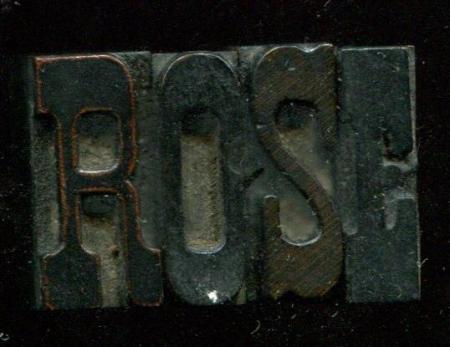Name this font contest- Rally?
Thanks all for your help on the Ornamental W font- the blocks found a nice home via the Briar Press classifieds :)
This font is a 6 line Hamilton font. The case was labeled “Rally” but I am never sure if this is accurate.
Any help is appreciated.
Thanks!
Christopher

font set rallyrose.jpg
French Claredon No. 2
Thanks!
Christopher,
Actually, the first three letters are from Hamilton’s Number 91 and the fourth letter is from Hamilton’s Number 24 (their cutting of French Clarendon). Care must be take when identifying type that only has a number and not a generic name.
Dave Greer
I have a poster printed with this type. That was printed at the museum of printing History in Houston by Gordon Rouse and it matched exactly except for the e upon closer inspection. It says the type is Hamilton from 1870.
Courtney,
If that is what is posted with the type, at the Museum, then it is just an example of mis-identification, since there was no Hamilton Mfg. Co., in 1870. I don’t want to blame Gordon for that error, though, or you for it, either. Some of Hamilton’s faces are easily mis-identified if you only have a couple of letters to look at!
Dave Greer
In my “system” for cataloging my own fonts, I list the manufacturer (if known) and the earliest traceable date that the design appeared. In Hamilton’s case, they continued to offer designs that had originated with their predecessors. So…..maybe this could be a Hamilton font of a face whose design existed c. 1870?
Rick
Rick,
Yes, this design is a basic “Egyptian Condensed” that Kelly shows as being first shown in Page’s specimens from 1872, My purpose for identifying the type, shown by Christopher, was that there would be less error when he listed it for sale. I see that it is now listed as “French Clarendon, No. 2”, which it is not. I, too, try to show the name of the font, in my card file, as the name that the particular manufacturer (if known) showed in their specimen book, just for accuracy. Hamilton may have used Page’s patterns for cutting that face but, since he used his numbering system, he did not call it Egyptian Condensed (Page’s name). Hamilton’s 20th-century catalogs had a numbering system that indicated whether it was from Wells’, Tubbs’ etc. patterns. so it was easier to tell where the face originated.
Dave
P.S. I’m surprised that no one commented on the inverted S!
Hi Dave,
Now you really have me intrigued! I did not know that Hamilton’s numbering system that indicated where the original patterns came from. This is fascinating. Thanks for the info.
Rick
Chris…. the S is upside down
Rick
To follow up on Mr Greer’s post, the Rob Roy Kelly American Wood Type Collection website lists (and shows) all the types in the Collection by name and cross lists against names used by competitors as well as the number Hamilton assigned to the types after acquisition. It only covers types in the Collection so is far from encyclopedic, but hopefully a useful place to start looking.
http://www.utexas.edu/cofa/a_ah/rrk/specimens.php
Hamilton series numbers applied to types produced by accquired competitors. [3000] Morgans & Wilcox; [4000] Page (also some [200] and [600]); [5000] Wells; [2000] Tubbs numbers were retained by Hamilton after aquisition.
David
Wow. How wonderful and what a relief to learn this bit about the Hamilton numbering system. Thank you David.